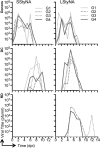The short stalk length of highly pathogenic avian influenza H5N1 virus neuraminidase limits transmission of pandemic H1N1 virus in ferrets
- PMID: 23864615
- PMCID: PMC3807409
- DOI: 10.1128/JVI.00967-13
The short stalk length of highly pathogenic avian influenza H5N1 virus neuraminidase limits transmission of pandemic H1N1 virus in ferrets
Abstract
H5N1 influenza viruses pose a pandemic threat but have not acquired the ability to support sustained transmission between mammals in nature. The restrictions to transmissibility of avian influenza viruses in mammals are multigenic, and overcoming them requires adaptations in hemagglutinin (HA) and PB2 genes. Here we propose that a further restriction to mammalian transmission of the majority of highly pathogenic avian influenza (HPAI) H5N1 viruses may be the short stalk length of the neuraminidase (NA) protein. This genetic feature is selected for when influenza viruses adapt to chickens. In our study, a recombinant virus with seven gene segments from a human isolate of the 2009 H1N1 pandemic combined with the NA gene from a typical chicken-adapted H5N1 virus with a short stalk did not support transmission by respiratory droplet between ferrets. This virus was also compromised in multicycle replication in cultures of human airway epithelial cells at 32°C. These defects correlated with a reduction in the ability of virus with a short-stalk NA to penetrate mucus and deaggregate virions. The deficiency in transmission and in cleavage of tethered substrates was overcome by increasing the stalk length of the NA protein. These observations suggest that H5N1 viruses that acquire a long-stalk NA through reassortment might be more likely to support transmission between humans. Phylogenetic analysis showed that reassortment with long-stalk NA occurred sporadically and as recently as 2011. However, all identified H5N1 viruses with a long-stalk NA lacked other mammalian adapting features and were thus several genetic steps away from becoming transmissible between humans.
Figures







References
-
- WHO 2013. Cumulative number of confirmed human cases of avian influenza A(H5N1) reported to WHO. WHO, Geneva, Switzerland: http://www.who.int/influenza/human_animal_interface/H5N1_cumulative_tabl...
-
- Yen H-L, Liang C, Wu C-Y, Forrest HL, Ferguson A, Choy K-T, Jones J, Wong DD-Y, Cheung PP-H, Hsu C, Li OT, Yuen KM, Chan RWY, Poon LLM, Chan MCW, Nicholls JM, Krauss S, Wong C-H, Guan Y, Webster RG, Webby RJ, Peiris M. 2011. Hemagglutinin-neuraminidase balance confers respiratory-droplet transmissibility of the pandemic H1N1 influenza virus in ferrets. Proc. Natl. Acad. Sci. U. S. A. 108:14264–14269 - PMC - PubMed
-
- Palese P, Tobita K, Ueda M, Compans RW. 1974. Characterization of temperature sensitive influenza virus mutants defective in neuraminidase. Virology 61:397–410 - PubMed
MeSH terms
Substances
Grants and funding
LinkOut - more resources
Full Text Sources
Other Literature Sources
Medical

